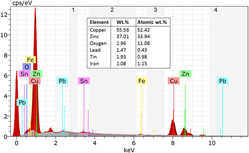Crossref Citations
This article has been cited by the following publications. This list is generated based on data provided by
Crossref.
Yin, Kedong
Zhang, Ya
and
Li, Xuemei
2017.
Research on Storm-Tide Disaster Losses in China Using a New Grey Relational Analysis Model with the Dispersion of Panel Data.
International Journal of Environmental Research and Public Health,
Vol. 14,
Issue. 11,
p.
1330.
Kandpal, Bhaskar Chandra
Kumar, Jatinder
and
Singh, Hari
2017.
Optimization and characterization of EDM of AA 6061/10%Al2O3 AMMC using Taguchi’s approach and utility concept.
Production & Manufacturing Research,
Vol. 5,
Issue. 1,
p.
351.
Sankar, V.
Arravind, R.
and
Manikandan, D.
2019.
Material synthesis, characterization, and machining performance of stir cast beryllium copper alloy composites.
Transactions of the Canadian Society for Mechanical Engineering,
Vol. 43,
Issue. 2,
p.
143.
Dai, Jin
He, Yuhong
Guo, Liang
and
Yin, Hang
2019.
A Flexible Grey Incidence Degree and Application for Unequal Length Sequence.
p.
613.
Srinivasan, D
Meignanamoorthy, M
and
Ravichandran, M
2019.
Optimization of process parameters of boron carbide filled Aluminium matrix composites using Grey Taguchi method.
Materials Research Express,
Vol. 6,
Issue. 7,
p.
076504.
Vairamuthu, J.
Stalin, B.
Natarajan, V. Ananda
Fazil, B. Mohmed
and
Balaji, R.
2020.
WITHDRAWN: Material synthesis and spark erosion behavior of tantalum carbide based duralumin metal matrix composite.
Materials Today: Proceedings,
Martin Sahayaraj, J.
Arravind, R.
Subramanian, P.
Marichamy, S.
and
Stalin, B.
2020.
Artificial neural network based prediction of responses on eglin steel using electrical discharge machining process.
Materials Today: Proceedings,
Vol. 33,
Issue. ,
p.
4417.
Anix Joel Singh, J.
Vishnu Vardhan, T.
Vairamuthu, J.
Stalin, B.
and
Subbiah, Ram
2020.
Analyses of particle size and abrasive water jet drilling of synthesized chromel metal matrix.
Materials Today: Proceedings,
Vol. 33,
Issue. ,
p.
4893.
Alagarsamy, S.V.
Ravichandran, M.
Meignanamoorthy, M.
Chanakyan, C.
Dinesh Kumar, S.
and
Sakthivelu, S.
2020.
Influence of CNC turning variables on high strength Beryllium-Copper (C17200) alloy using tungsten carbide insert.
Materials Today: Proceedings,
Vol. 27,
Issue. ,
p.
925.
Mohan Babu, P.
Rajamuneeswaran, S.
Pritima, D.
Marichamy, S.
and
Vairamuthu, J.
2020.
Spark erosion machining behaviour of coconut shell ash reinforced silicon metal matrix.
Materials Today: Proceedings,
Vol. 33,
Issue. ,
p.
4602.
Malini, T.
Sudha, R.
Anantha Christu Raj, P.
and
Stalin, B.
2020.
The role of RTD and liquid sensors in electric arc furnace for melting of aluminium.
Materials Today: Proceedings,
Vol. 33,
Issue. ,
p.
4793.
Rani, S. Sheeba
Sundari, V. Kamatchi
Jose, P. Subha Hency
Sivaranjani, S.
Stalin, B.
and
Pritima, D.
2020.
Enrichment of material subtraction rate on Eglin steel using electrical discharge machining process through modification of electrical circuits.
Materials Today: Proceedings,
Vol. 33,
Issue. ,
p.
4428.
Geethamani, R.
Jaganathan, S.
Prem Anand, S.
Sheeba Rani, S.
and
Stalin, B.
2020.
Heat capacity improvement in the electric furnace through amendment of the electric circuit on melting of hardox steel.
Materials Today: Proceedings,
Vol. 33,
Issue. ,
p.
4784.
Stalin, B.
Vardhan, T. Vishnu
Marichamy, S.
Vairamuthu, J.
Ravichandran, M.
and
Dhinakaran, V.
2020.
Investigations on ultrasonic machining of tellurium copper metal matrix.
Vol. 2283,
Issue. ,
p.
020053.
Pritima, D.
Vairamuthu, J.
Gopi Krishnan, P.
Marichamy, S.
Stalin, B.
and
Sheeba Rani, S.
2020.
Response analysis on synthesized aluminium-scandium metal matrix composite using unconventional machining processes.
Materials Today: Proceedings,
Vol. 33,
Issue. ,
p.
4431.
Radhika, A.
Thenmozhi, G.
Balakarthikeyan, M.
and
Stalin, B.
2020.
Enhancement of welding strength through electric current and resistance on ERSW process using chromium steel.
Materials Today: Proceedings,
Vol. 33,
Issue. ,
p.
4781.
Sathish, S.
Shaikh, Mubeen
Girisha, L.
Senthil Kumar, R.
Ramesh Kumar, M.
and
Subbiah, Ram
2021.
Evaluation of hardness and analysis of parameters on reinforced Al-MMC.
Materials Today: Proceedings,
Vol. 47,
Issue. ,
p.
4341.
Prathusha, D.
Venkatesh, J.
Arun, K.K.
Kumar, Kulkarni Sanjay
Prabhu, S.
and
Subbiah, Ram
2021.
Machining behaviors of nickel titanium composite using non-traditional machining processes.
Materials Today: Proceedings,
Vol. 47,
Issue. ,
p.
4312.
Sahu, Jambeswar
and
Shrivastava, Sonam
2021.
Fuzzy based multi-response optimization: a case study on EDM machining process.
SN Applied Sciences,
Vol. 3,
Issue. 7,
Srinivasan, D
Veerappan, G
M, Ravichandran
Chairman, C Anand
Marichamy, S
Mohanavel, V
and
Karthick, A
2021.
Investigation on electric erosion behavior of nickel-based super alloy (Waspaloy: Ni, Cr, Co, Mo, Ti, Al) using response surface methodology.
Surface Topography: Metrology and Properties,
Vol. 9,
Issue. 3,
p.
035006.






